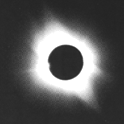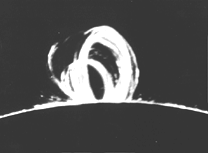The Layers of the Sun
The Sun is much too hot for its matter to be anything but gas. In fact, the heat is so intense that collisions between atoms often tear off one or more electrons, creating a "plasma, " a gas in which at least an appreciable fraction of the particles are free electrons and "positive ions," atoms temporarily missing electrons. Because plasmas contain electrically charged particles, they can carry electric currents, adding a completely new range of phenomena to their behavior.
What appears to us as the "surface" of the Sun is actually a relatively thin layer (about 100 km or so, which is 1/7000 of the Sun's radius) called the photosphere. Layers below it cannot be seen, but as in the Earth's atmosphere, one expects them to become progressively denser with increasing depth, compressed by the weight of the layers on top of them. They are also presumed to get increasingly hotter, since the Sun's heat is generated in its core and flows outwards.
 Similarly, as one proceeds upwards from the photosphere, layers of the solar atmosphere become increasingly rarefied, and become transparent to the light coming from below them. Until the 20th century, these layers could only be observed during a total solar eclipse, when the disk of the Sun was blocked by the Moon.
Similarly, as one proceeds upwards from the photosphere, layers of the solar atmosphere become increasingly rarefied, and become transparent to the light coming from below them. Until the 20th century, these layers could only be observed during a total solar eclipse, when the disk of the Sun was blocked by the Moon.
Observations of the eclipsed Sun show the next layer above the photosphere--the reddish chromosphere ("chromos"=color), about 5000 km thick. Above that came the solar corona ("crown"), glowing tufts that faded into the distance, though time exposures with sensitive cameras managed to trace them to several solar radii.
 Above the middle latitudes of the Sun the streaks of the corona sometimes displayed arches, suggesting that magnetic fields there determined its structure. That impression was reinforced by "polar plumes" above the north and south poles, spread out like the iron filings at the ends of a magnet, suggesting that the Sun, like the Earth, had two magnetic poles.
Above the middle latitudes of the Sun the streaks of the corona sometimes displayed arches, suggesting that magnetic fields there determined its structure. That impression was reinforced by "polar plumes" above the north and south poles, spread out like the iron filings at the ends of a magnet, suggesting that the Sun, like the Earth, had two magnetic poles.
The heat of the Corona
The most interesting feature of the chromosphere and corona is that they are much hotter than the photosphere, even though any solar energy reaching them comes from the cooler region below.
The high temperature is inferred from the light emitted by their atoms. In a rarefied hot gas, emitted light no longer follows a simple pattern dictated by the temperature, like red-hot iron or a lightbulb filament (both of which are solid matter). Instead (see section S-4), it is concentrated in narrow ranges of color ("spectral lines") which depend on the atoms from which they came. Observations of emissions from atoms (or rather, ions) such as iron with 13 of its electrons missing suggest a coronal temperature of around 1,000,000°C (degrees Celsius), while emissions from chromospheric ions similarly suggest about 30,000°C.
The high temperature of the corona can also be seen from the x-rays and the extreme ultra-violet light which it emits, and indeed, images in these emissions (which must be taken outside the atmosphere) are now the preferred way of observing the corona (see section S-6). Such an image, color-coded to indicate regions of different temperature, is linked here. It shows that the heat is not evenly distributed:
The way the corona is heated is a mystery. It cannot be ordinary heat flow from the photosphere below, because ordinary heat radiation can never create a temperature higher than that of its source. Suppose you concentrate sunlight with magnifying glasses and mirrors, and suppose you somehow keep your sample from evaporating. You can never get it hotter than the Sun. As the sample heats up, it too radiates, and by the time its temperature reaches that of the Sun, it loses as much heat as it gains.
Some early theories proposed that the energy was coming from the outside, in the form of a steady rain of meteorites, greatly accelerated by the Sun's gravity, but that was soon disproved. Today it is believed that some plasma process is responsible, fed by local magnetic fields, but we really do not know much about that process. One idea is that it creates a sub-population of very fast ions, which do not share their energy because of the lack of collisions. At levels above the photosphere, solar gravity holds back the slower component, so that only very hot ions populate the higher layers, giving the corona a very high effective temperature.
Other theories suggested that plasma waves coming from the photosphere arrived in the corona and, unable to proceed into the rarefied gas, dissipated their energy. Because the gas receiving that energy is so rarefied, it is heated up to a high temperature. The problem was that proposed plasma wave modes tend to be reflected back downwards, rather than dissipating their energy.
Current explanations (as of 2016) credit magnetic turbulence and "micro flares" associated with magnetic fields, but a satisfying full solution remains elusive.
(For more about the corona, see here.)
The Solar Wind
In any atmosphere, the average velocity of atoms, molecules and ions depends on their temperature. Individual velocities, however, are spread out around this average, and a few particles are always fast enough to "evaporate" and escape the restraining gravity.
Our Moon's gravity is weak, equal at the Moon's surface to 1/6 of the Earth's. It is believed that even if the Moon once had an atmosphere, it would have evaporated long ago. The stronger gravity of Earth, on the other hand, has managed to hold on to a substantial atmosphere, on which all terrestrial life depends.
The Sun's gravity is much stronger, but a million-degree atmosphere is too much for it. As a result, a steady stream of hot plasma known as the solar wind flows out of the corona into space. The corona, however, is not likely to disappear any time soon, since it is constantly replenished from below. The solar wind was predicted by Eugene Parker in 1958 and its existence received early confirmation from scientific instruments aboard NASA's Explorer 10 in 1961 and from the interplanetary probe Mariner 2 in 1962. The solar wind has also been suggested as a source of outward thrust for small interplanetary probes.
At the orbit of the Earth, the solar wind has an average density of about 6 ions/cm3, compared to 2.5 1019 molecules/cm3 in the Earth's sea-level atmosphere; it is more rarefied than the best laboratory vacuum. Earth receives solar wind from low and middle latitudes of the Sun, with an average outwards speed of 400 km/sec in the direction of Earth; above the Sun's poles the velocity nearly doubles, as reported by the Ulysses space probe. Past the Earth's orbit, the solar wind continues with undiminished speed (but with decreasing density, as its particles spread out), well past the orbit of Pluto. Space probes Voyager 1 and 2, now racing away from the Sun, have crossed the terminal shock of the solar wind and explored the region around its outer boundary ("heliopause").
Exploring Further
"Sun Observer's Guide" by Pam Spence,159 pp., Firefly Books, 2004. A concise and readable overview.
Questions from Users:
The color and temperature of stars and of the Sun
***
Questions about the Solar Corona:
(1) Why don't its particles separate by weight?
(2) What accelerates the solar wind?
***
The Sun's Axis
***
Sound Waves on the Sun?
;
***
What heats the Solar Corona?

 Similarly, as one proceeds upwards from the photosphere, layers of the solar atmosphere become increasingly rarefied, and become transparent to the light coming from below them. Until the 20th century, these layers could only be observed during a total solar eclipse, when the disk of the Sun was blocked by the Moon.
Similarly, as one proceeds upwards from the photosphere, layers of the solar atmosphere become increasingly rarefied, and become transparent to the light coming from below them. Until the 20th century, these layers could only be observed during a total solar eclipse, when the disk of the Sun was blocked by the Moon.
 Above the middle latitudes of the Sun the streaks of the corona sometimes displayed arches, suggesting that magnetic fields there determined its structure. That impression was reinforced by "polar plumes" above the north and south poles, spread out like the iron filings at the ends of a magnet, suggesting that the Sun, like the Earth, had two magnetic poles.
Above the middle latitudes of the Sun the streaks of the corona sometimes displayed arches, suggesting that magnetic fields there determined its structure. That impression was reinforced by "polar plumes" above the north and south poles, spread out like the iron filings at the ends of a magnet, suggesting that the Sun, like the Earth, had two magnetic poles. 